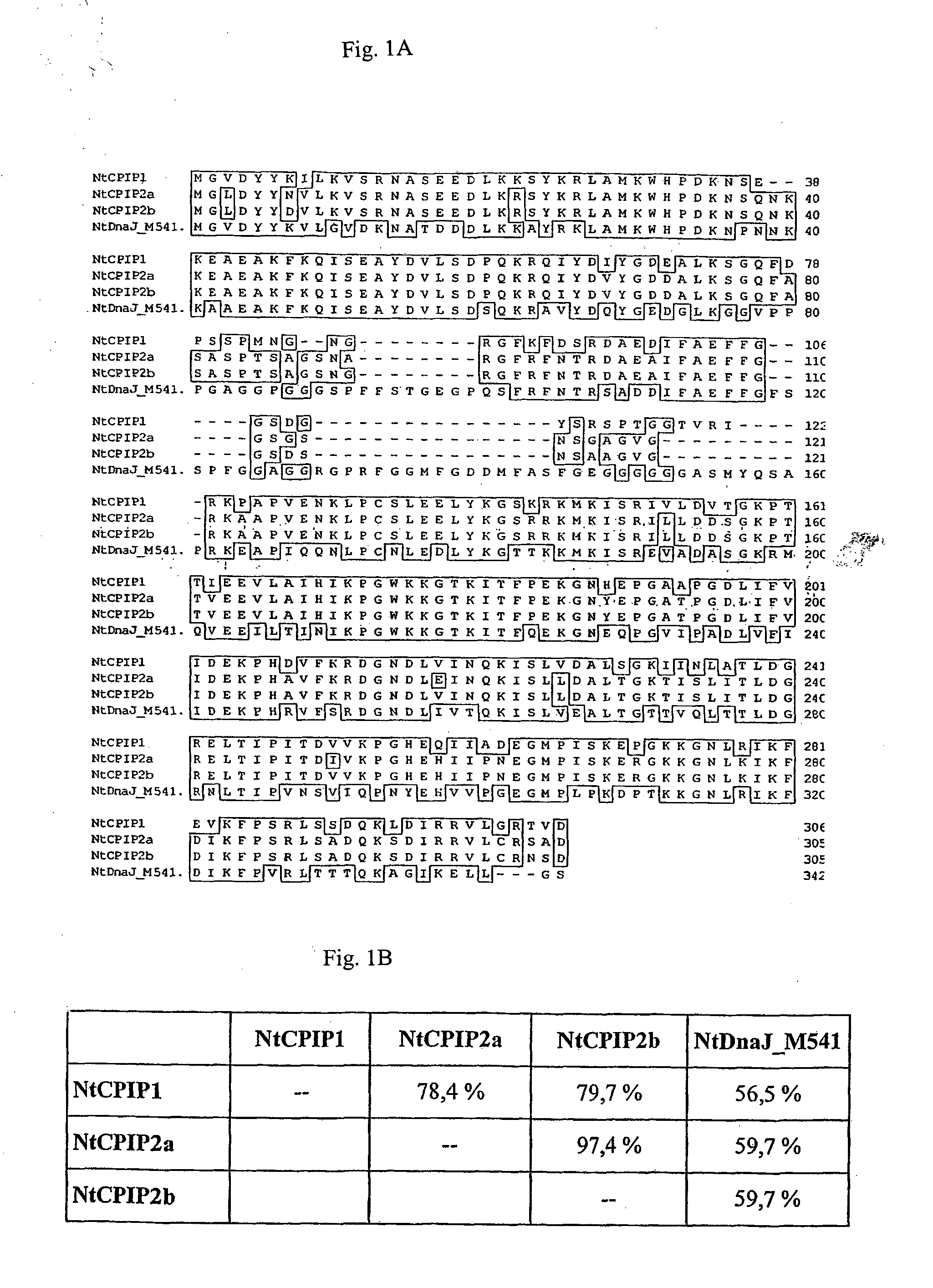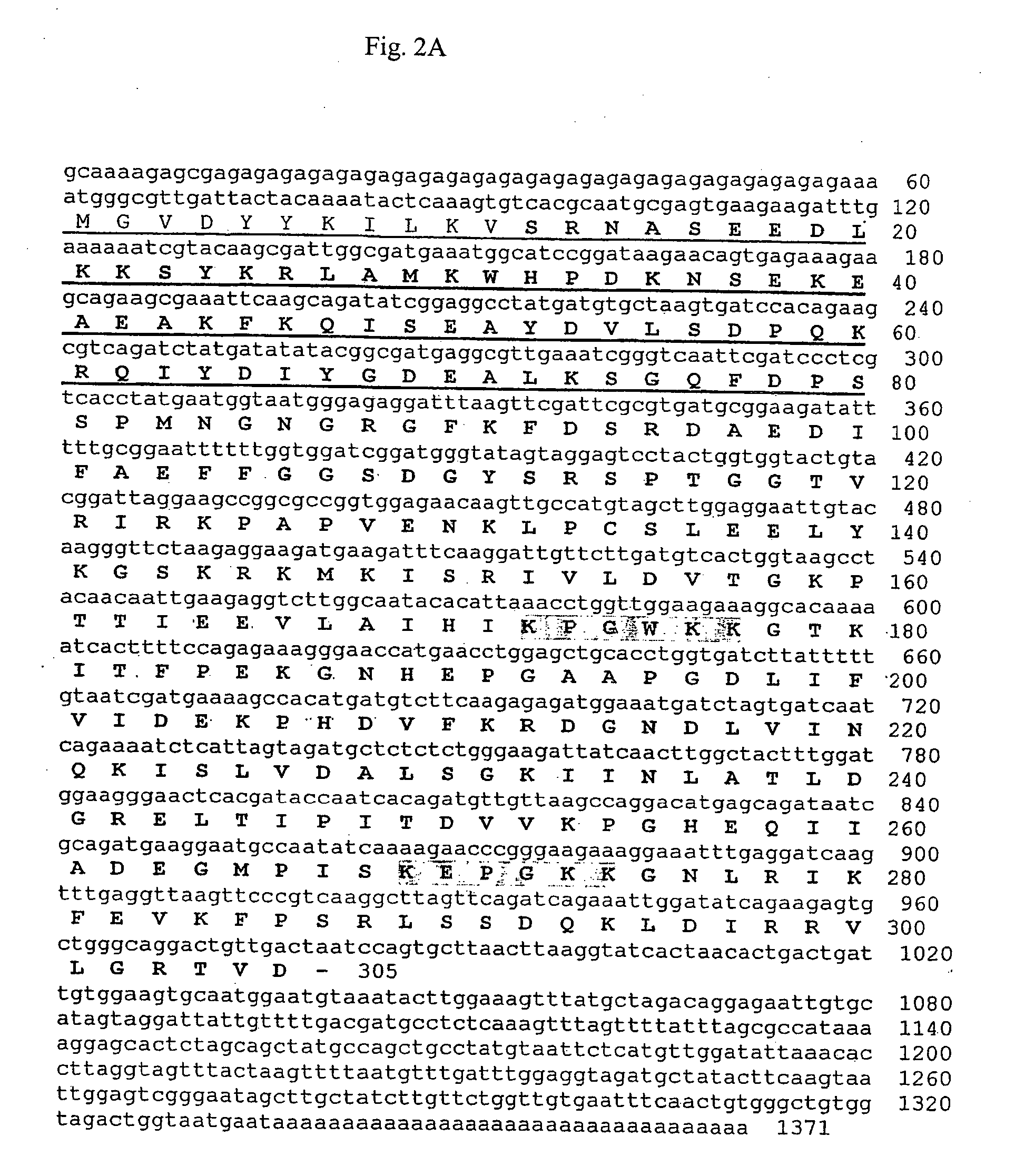Method for the production of transgenic plants with increased virus resistance by silencing vegetable DnaJ-like proteins
a technology of vegetable dnaj and protein, which is applied in the field of plant cells and plants, can solve the problems of only being resistant to a very specific type of virus infection, not being induced strong enough to stave off the virus infection, and significant crop failure, etc., and achieves the effect of increasing virus resistance, increasing virus resistance, and being easy to put into practi
- Summary
- Abstract
- Description
- Claims
- Application Information
AI Technical Summary
Benefits of technology
Problems solved by technology
Method used
Image
Examples
example 1
Identification of Plant DnaJ-Like Proteins which Interact with Viral Components
[0208] The following example shows how plant DnaJ-like proteins were identified from Nicotiana tabacum by a two-hybrid screen which interact with the capsid protein (CP) from potato virus Y (PVY) and tobacco etch virus (TEV). In order to give a more concise overview, the methods and materials used within the framework of this experiment will first be discussed.
General Cloning Processes
[0209] Cloning processes such as: restriction digest, DNA isolation, agarose gel electrophoresis, purification of DNA fragments, transfer of nucleic acids to nitrocellulose and nylon membranes, linking of DNA fragments, transformation of E. coli cells, culture of bacteria, and sequence analysis of recombinant DNA were carried out as described by Sambrook et al. (vide supra.) The transformation of Agrobacterium tumefaciens was realized according to the method of Hofgen and Willmitzer (Nucl. Acid Res. (1988) 16, 9877). The...
example 2
Characterization of the Binding Specificity of NtCPIP1
[0223] In order to characterize the binding specificity of NtCPIP1, NtCPIP2a and NtCPIP2b, additional potyviral capsid proteins were tested for interaction with NtCPIP1, NtCPIP2a and NtCPIP2b in the yeast two hybrid system. The sequences encoding the capsid proteins of the Tobacco etch virus (TEV, Gene Bank Accession M15239, bases 8518-9309), Tobacco vein mottling virus (TVMV, Gene Bank Accession X04083, bases 2759-3024), Turnip mosaic virus (TUMV, Gene Bank Accession D10601, bases 4027-4890) and Potato virus A (PVA strain DAT, Gene Bank Accession AJ2963 11, bases 8532-9338) were ligated with the GAL4 binding domain in the pGBT9 or pGBKT7 (Clontech) vector in an open reading frame, and the plasmids obtained were co-transformed with pAD-CPIP29 (plasmid deriving from the primary yeast-two-hybrid screen) into the reporter strain Y190.
[0224] The yeasts were selected for 3-4 days on SD Trp− / Leu− medium and tested for expression of t...
example 3
Detailed Characterization of the Interaction of PVY CP with NtCPIP1
[0225] In the following experiment it was investigated which region of PVY CP is responsible for the interaction with NtCPIP1. For this, a series of N- or C-terminal deleted fragments of CP and a series of CP point mutants were produced as GAL4 binding domain fusion proteins.
Generation of Point Mutants and Deletion Mutants for the Two Hybrid Analysis
[0226] Single and double amino acid substitution mutations were introduced in the coding sequence of the PVY CP core region by means of site directed mutagenesis. The “Quick change site-directed mutagenesis” kit (Stratagene) and respective oligonucleotides were also used according to the manufacturer's instructions. For the production of the single amino acid substitution mutants S125W, R157D and D201R, the pGEM / T-PVY CP plasmid was used as template. Double amino acid substitution mutants of PVY CP were obtained by introducing the S125W or D201R mutation into the plas...
PUM
| Property | Measurement | Unit |
|---|---|---|
| Fraction | aaaaa | aaaaa |
| Fraction | aaaaa | aaaaa |
| Fraction | aaaaa | aaaaa |
Abstract
Description
Claims
Application Information
 Login to View More
Login to View More - R&D
- Intellectual Property
- Life Sciences
- Materials
- Tech Scout
- Unparalleled Data Quality
- Higher Quality Content
- 60% Fewer Hallucinations
Browse by: Latest US Patents, China's latest patents, Technical Efficacy Thesaurus, Application Domain, Technology Topic, Popular Technical Reports.
© 2025 PatSnap. All rights reserved.Legal|Privacy policy|Modern Slavery Act Transparency Statement|Sitemap|About US| Contact US: help@patsnap.com



